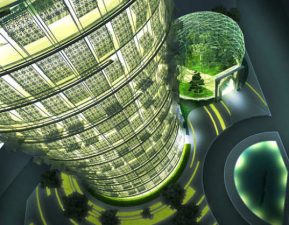 Israeli Haim Dotan incorporates the soul of nature into his art and architecture
Israeli Haim Dotan incorporates the soul of nature into his art and architecture
Few things make our green hearts soar more than an architect with a gentle, artistic, nature-loving touch. Although we learned this week that cave homes built into volcanic rock withstood seven centuries of time’s wrath, it is also true that dense urban centers are more sustainable in the long run. Haim Dotan, the Israeli architect who designed Israel’s “Seashell” pavilion for the 2010 Shanghai World Expo, and who is presently designing the Aora Solar Tower in Israel, describes his architectural philosophy for Shanghai Daily writer Yao Minji.
It isn’t every day that we are able to feature an architect who is also an artist, a poet, and an educator. Dotan, sometimes known by his Chinese name Dutang Hai that aptly translates as “crossing ocean,” has not only achieved extraordinary acclaim for his curved architecture, but has recently published two books of poetry.
In order to understand what informs the language of his architecture, it helps to read a few lines of his literary art, which is often accompanied by beautiful nature photographs: dripping spider webs, and mist-shrouded lakes.
The soul of materials
“After the rain, light reveals inner soul of old wood,” one line reads besides a shimmering bench.
It’s not just the soul of materials that the architect internalizes, but how the materials put together interact with one another.
“All these vertical buildings are like walls,” he told Minji. They block the sunshine, the clouds, the sky from us. I can’t bear the idea that our children will be living in cities blocked by these walls.”
Dotan’s buildings are typically softer, more permissive. They let in the air. They let in the sun.
“It is like what Laozi says about wuwei (doing nothing/not disturbing the order of things). Build less and be less controlled, just let things happen naturally,” Dotan tells Minji.
“The Israel Pavilion, aka the Seashell, is composed of two architectural curvilinear forms, one of stone symbolizing the past and the other of glass symbolizing the future, embracing each other,” according to Minji. The Aora Solar Energy Tower in Samar, Israel, on the other hand, is “a bright yellow sunflower-inspired tower, a blossom on top of a long thin stem.”
Dotan worked as a construction worker in California before graduating from the University of Southern California in Los Angeles with B.Arch. and M.Arch. degrees in 1984. He then established his own architectural firm in 1990 in Tel Aviv after testing the waters in Manhattan, Tokyo, and Sidney.
Natural accolades
Since then, he has designed symphonic structures that sing in Asia, the Persian Gulf, Africa, Israel, and Europe, and has received numerous awards. These include the Israel Foreign Ministry DBOT Tender as the developer, contractor and architect of the Israel Pavilion, the 2007 nomination for the Israel Prize in Architecture, and the 2006 Israeli Building Construction Center Award for “New Architectural Language in Israel through 17 years of Development and Improvement of New Building Technologies.”
Haim Dotan also spreads his worthy mandate of building in harmony with nature as senior lecturer at the esteemed Bezalel Academy of Fine Arts in Jerusalem.
To view a fuller illustration of his work and selections from his travel sketches and other art, please visit his website.
More Architecture News:





